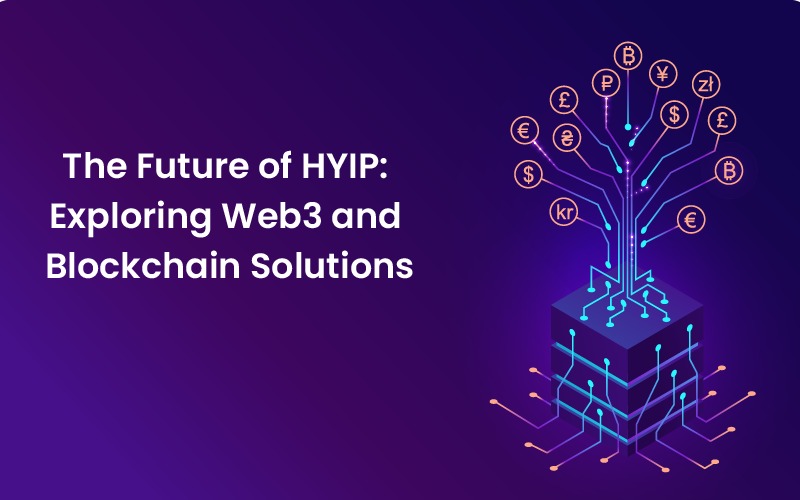High-Yield Investment Programs (HYIPs) have long been a controversial segment of the investment world. While they promise enticing returns, they are often plagued by issues like lack of transparency, fraud, and unsustainable models. Future of HYIP and Blockchain Solutions – However, the advent of Web3 and blockchain technology presents a transformative opportunity for HYIPs, offering solutions that could redefine how these programs operate and how investors perceive them.
Understanding HYIPs in Their Current Form
HYIPs are investment schemes that typically offer extremely high returns in a short period. These programs often rely on a Ponzi-like structure, where returns for early investors are paid from the capital of newer investors rather than legitimate profits. Due to this structure, many HYIPs fail or turn out to be scams, leading to significant losses for participants.
The lack of transparency and regulatory oversight in traditional HYIPs is a significant drawback. Investors are often left in the dark about how funds are managed, creating an environment ripe for exploitation. This is where Web3 and blockchain technologies can offer innovative solutions.
Web3: The New Frontier for Investment
Web3, often described as the next iteration of the internet, is characterized by decentralization, transparency, and user control. By leveraging blockchain technology, Web3 applications create trustless systems where transactions and operations are visible and verifiable by all participants. This has profound implications for the HYIP ecosystem:
- Decentralization: Blockchain technology eliminates the need for centralized authorities or intermediaries. In a Web3-powered HYIP, all transactions and fund flows can be recorded on a decentralized ledger, ensuring no single entity can manipulate the system.
- Transparency: With blockchain’s immutable nature, every transaction is publicly visible and cannot be altered. This ensures that investors can verify where their funds are going and how returns are being generated.
- Smart Contracts: Smart contracts, self-executing agreements coded on the blockchain, can automate payouts and investment processes. This removes the risk of human error or intentional fraud, as terms are enforced automatically.
- Tokenization: Blockchain allows for the tokenization of assets, enabling fractional investments and liquidity. HYIPs could issue tokens representing a stake in the program, making it easier for investors to buy in or cash out.
Blockchain Solutions for Key HYIP Challenges
By integrating blockchain solutions, HYIPs can address many of the issues that have historically undermined their credibility:
- Enhanced Security: Blockchain’s cryptographic protocols provide robust security against hacking and unauthorized access, safeguarding investor funds.
- Immutable Records: Every transaction recorded on the blockchain is permanent and transparent. This discourages fraudulent activities and fosters trust among investors.
- Global Accessibility: Blockchain enables borderless transactions, making HYIPs accessible to a broader range of investors. This global reach can enhance liquidity and diversify the investor base.
- Regulatory Compliance: Blockchain’s transparent nature can facilitate compliance with financial regulations. Regulators can audit blockchain-based HYIPs in real time, ensuring accountability.
Real-World Examples and Applications
Several blockchain-based projects have already demonstrated the potential of Web3 for investment programs:
- Decentralized Finance (DeFi): DeFi platforms like Aave and Compound allow users to earn high yields on cryptocurrency deposits through lending and borrowing protocols. These platforms operate transparently on blockchain networks, showcasing how decentralized models can offer high returns without compromising security.
- Smart Contract Audits: Companies like CertiK and OpenZeppelin specialize in auditing smart contracts to ensure they are secure and function as intended. This adds a layer of trust for blockchain-based HYIPs.
Challenges to Overcome
While Web3 and blockchain offer promising solutions, there are challenges that need to be addressed:
- Scalability: Blockchain networks like Ethereum often face scalability issues, leading to high transaction fees and slow processing times. Layer 2 solutions and alternative blockchains may alleviate this problem.
- User Education: Many potential investors are unfamiliar with blockchain technology, making it essential to provide user-friendly platforms and educational resources.
- Regulatory Uncertainty: Governments around the world are still formulating policies for blockchain and cryptocurrency. Regulatory clarity will be crucial for the widespread adoption of blockchain-based HYIPs.
The Future Outlook
The integration of Web3 and blockchain solutions into the HYIP sector has the potential to legitimize these programs and attract a broader, more informed investor base. By addressing core issues like transparency, security, and sustainability, blockchain technology could pave the way for a new generation of HYIPs that are more reliable and accessible.
Investors, however, must remain vigilant and conduct thorough due diligence, even in a blockchain-based ecosystem. While technology can minimize risks, it cannot eliminate them entirely.

